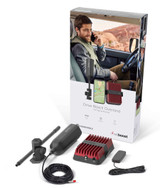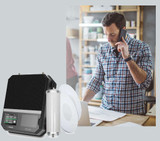How Cellular Repeaters Work
Here are some basics on how cellular repeater systems work.
A basic cell phone repeater system consists of:
- Outside Antenna
- Cellular Amplifier
- Inside Antenna
The Outside antenna communicates with the towers, the signal runs through a low-loss cable to the cellular amplifier. A Wilson Smart Tech amplifier can add 65db of power and send it through another cable to the inside antenna, which radiates the signal through the air, to your device.
Gains-Losses: Everything here is designed to take the power (measured in dB) from outside and maximize it on the inside.
Phone:
- The tower sends out a certain amount of power. As it travels through the air, it becomes attenuated (reduced).
- Our cell phone receives the signal the signal with its 0dB gain antenna. When you’re standing outside for example, test mode might tell you it’s receiving -80dB of power (closer to zero is better)
That’s usable, since your phone can pick up a signal as weak as -105dB
Repeater:
- Tower transmits, signal is attenuated as it travels.
- The outside antenna on top of the building is more focused in the direction of the tower, so it has better gain, let’s say +5dB
- Now you have -75dB going into the wire. The wire has losses with every foot, so let’s assume -3dB for the whole thing.
- -78dB going into the booster. The amp adds 65dB to the signal, which puts us at -13dB.
- Another -3 through the inside cable and +3 from the dome inside antenna.
Now, at the end of the whole process, you have -13dB coming from your antenna. That is more than enough power for your phone to read the signal very clearly. How far will that signal go? If you can pick up signals as weak as 105dB from your phone, then (105dB – 13dB = 92dB) you hae a 92dB excess. So, if we lost less than 92dB, we could still use the phone. It takes about 90 feet of air travel to lose that much power when running at 1900Mhz (800Mhz goes much further), which means you can step 90 feet from the antenna and still use your phone (just barely). Going through objects however, that number may change.
When you split the signal between two antennas, expect the coverage to be split by the same ratio.
- A 50/50 split reduces the signal by 3dB on each leg.
- Have taps that splits with a loss of 1.5dB on one leg and 6dB on the other. I recommend those if you want to run 3 or 4 antenna in a line.
- Another tap loses .5dB on one leg and 10dB on the other. I recommend those if you are using even more antennas and/or a secondary booster in the mix.
That’s the basics of how these things work, slightly geared toward your particular situation.
Recent Posts
-
weBoost Overland Signal Booster For Rugged, Off-Road Adventure
The New weBoost Drive Reach Overland The weBoost new Drive Reach Overland is the ideal booster fo …Dec 02, 2022 -
The New weBoost Signal Booster Set Up App
Installing Your weBoost Signal Booster System Just Got Easier weBoost has released a new app to he …May 20, 2022 -
The New weBoost INSTALLED Office Signal Booster System
Get A Signal Booster System - Installed At Your BusinessOffices . Retail Store …Nov 18, 2021



